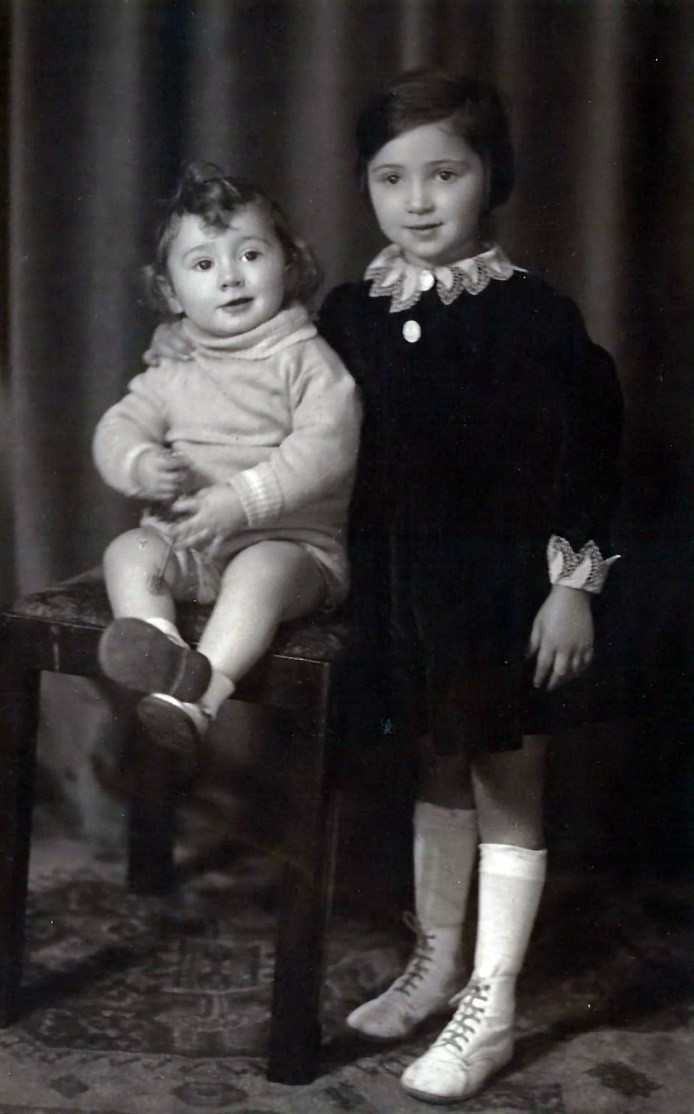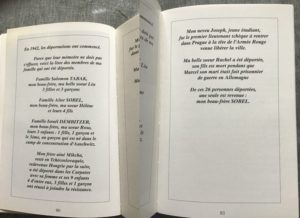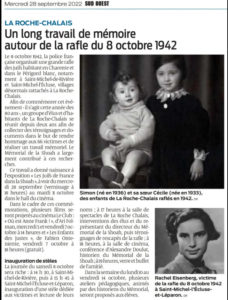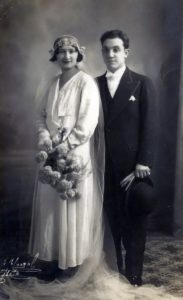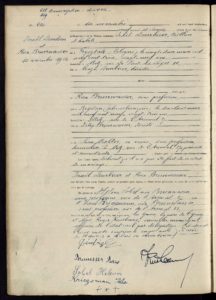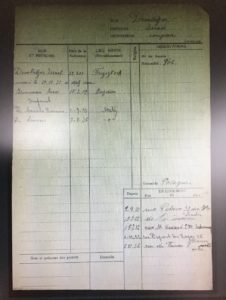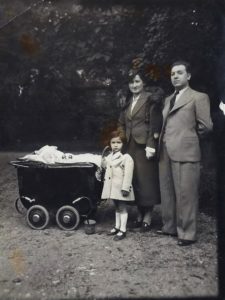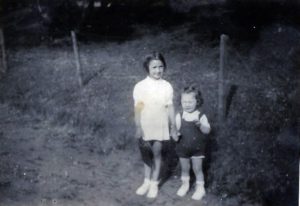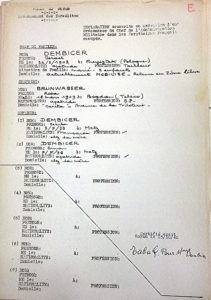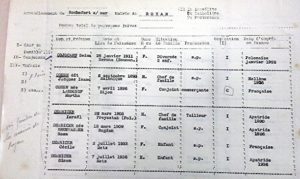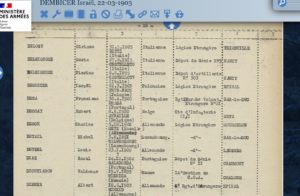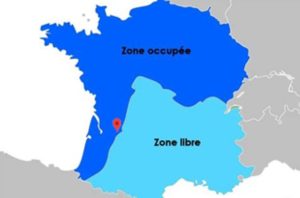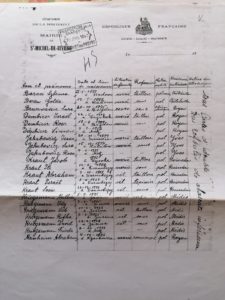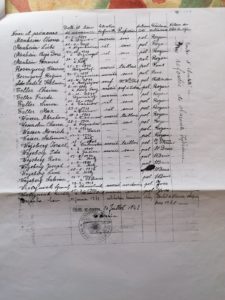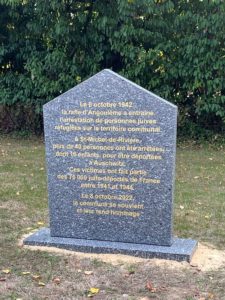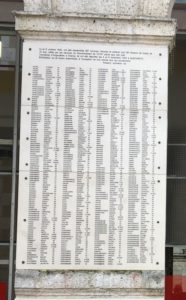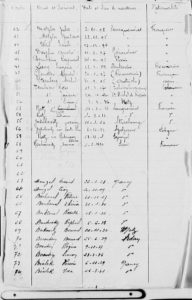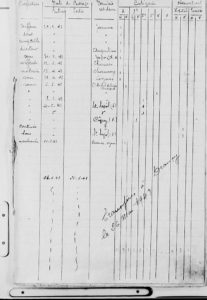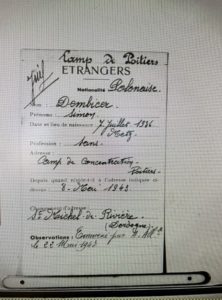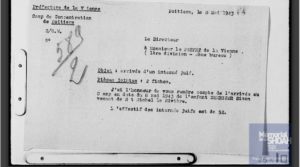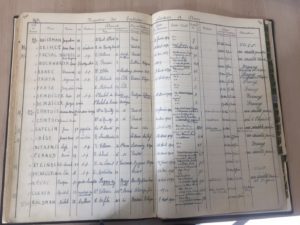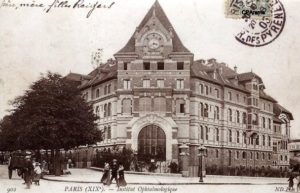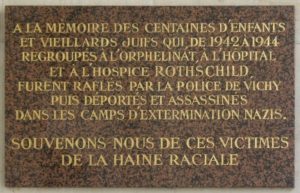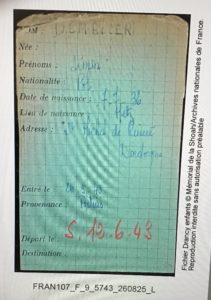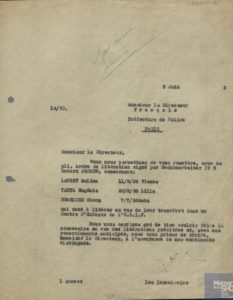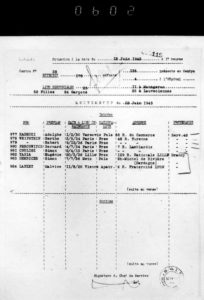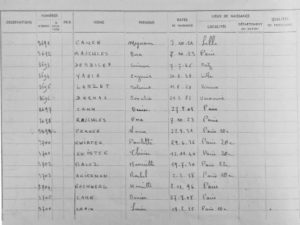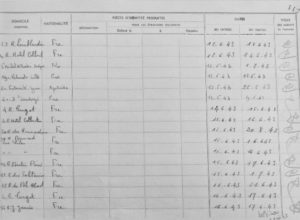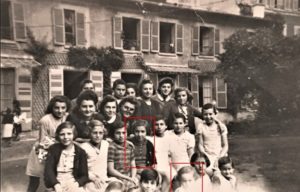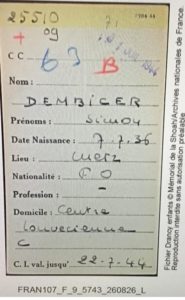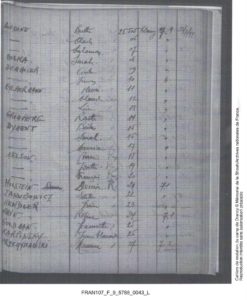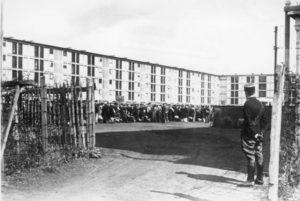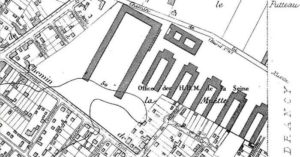Simon DEMBICER
Photo of Simon Dembicer with his sister Cécile around 1938 (Family archives)
The beginning of our investigation
During World War II, 6 million Jews died, out of the 11 million who were living in Europe in 1939. Among them were all of the Dembicer family, who prior to 1939 were living in Metz, in the Moselle department of France.
We are a class of 35 10th grade students from the Louis Vincent high school in Metz. This is why we were interested in this family, which also came from Metz. Thanks to the help of Julia Ghisalberti, Simon and Cécile Dembicer, we were lucky enough to gather a number of documents and other information. She carried out extensive research and introduced us to her grandfather Boumi Brunwasser’s book, Sur le chemin de ma vie, (On my life’s journey), in which he writes about the 26 members of his family who died during the Holocaust.
The First and fourth cover pages of the book Sur le chemin de ma vie, by Boumi Brunwasser.
(Family archives)
Pages 80 and 81 of the book Sur le chemin de ma vie, by Boumi Brunwasser.
(Family archives)
We also had the opportunity to work in partnership with students from the Jeanne d’Arc junior high school in la Roche-Chalais, in the Dordogne department.
Joint investigation with students from Metz-Saint Michel de Rivière (junior high and high school)
Photo of the class of 9th grade students at the Jeanne d’Arc junior high school at La Roche-Chalais with their history teacher, Mr. Abdelli.
(2022-2023 school year)
Article in the Sud-Ouest newspaper published on September 28, 2022 to mark the inauguration of a memorial to the victims of the roundup at La Roche-Chalais on October 8, 1942.
In September 2022, when we found out that there was going to be a memorial day at Saint-Michel de Rivière on October 7, we began working in partnership with some junior high school students from La Roche-Chalais. La Roche-Chalais now includes several former municipalities, including Saint-Michel de Rivière, where the Dembicer family lived during the war. Together with our fellow students, we held several video conferences. They carried out a survey of local residents to gather information about the Dembicer family and other Jewish families who had taken refuge there during the war. They were actively involved in the ceremony held on October 8, 2022 to commemorate the 80th anniversary of the roundup at the Philharmonic Hall in Angoulême, during which some memorial stones were unveiled. Among the 200 or so people who attended the event were not only some Holocaust survivors, but also Julia Ghisalberti and several members of her family. This partnership proved extremely helpful to us.
The ceremony in Saint-Michel de Rivière on October 8 began at 2.30pm with the unveiling of the memorial, which was followed by speeches by elected representatives, reading out the names of the victims, a minute’s silence and laying flowers. Lectures by historians, speeches by family members and schoolchildren rounded off the day’s events.
We are extremely grateful to our fellow members for their cooperation, during which we shared news of our findings. Thanks to them, to Julia and to documents we collected from various archives services, we have been able to piece together the broad outlines of Simon’s life story.
The family’s time in Metz prior to 1940
Simon Dembicer was born on July 7, 1936 at the Belle-Isle hospital in Metz, as was his older sister Cécile, who was born almost exactly three years earlier. Their parents, both of whom had migrated to France, were Rose and Israël Dembicer. His mother, Rose Brunwasser, was born in Bogdan, Czechoslovakia, on March 18, 1909, and migrated to France in 1926 together with her parents and eight siblings. The whole family lived at 37 rue de l’Arsenal, in the Jewish quarter of Metz, near the synagogue. Rose’s father, Zelig, who was a cobbler, died in 1931. According to the records, Rose was either a seamstress or did not work outside the home. On her marriage certificate, she signed her name awkwardly and spelled it “Brunsser”, which suggests that she had difficulty writing.
Israël Dembicer was born on March 22, 1903 in Freystak, Poland, and worked as a tailor. According to his address card, he migrated to Metz on September 2, 1930. When he arrived, he was single. He initially stayed with a widow at 33 rue Pétain, where he probably rented a room. In July 1932, shortly before he married Rose (at Metz City Hall on November10, 1932), he moved to 32 rue Saint Médard, and then in November to 18 rue Dupont des Loges. This was where Simon lived for the first few months of his life. On December 1, 1936, however, the Dembicers moved out of the house, and Sura Bruwasser, Rose’s mother, took it over. They probably moved because the family was growing, but perhaps also due to problems with the neighbors (which are discussed in Cécile’s biography), which resulted in the Dembicers being ordered to leave the country. They were not expelled in the end, however, largely because Rose was pregnant with Simon. The family then moved to 8 rue du Faisan.
Israel and Rose kept their original nationalities. Unlike Cécile, who was declared a French citizen shortly after she was born, Simon was a Polish citizen, like his father. This may have been an attempt to avoid his French military service. It may also have been due to the expulsion order, which would have made the family aware of how precarious their situation was in France.
Rose et Israël Dembicer’s wedding photo.
(Family archives)
Rose and Israël Dembicer’s marriage certificate, issued on November 19, 1932.
(Metz municipal archives)
Israël Dembicer’s address record.
(Metz municipal archives)
Unfortunately, we have no direct testimonies that might give us an insight into Cécile’s, Simon’s or their parents’ characters, nor do we have any personal documentation or possessions. However, we do have a number of photos which suggest that the children were cheerful and easy going, and show that they were always well-dressed, which is understandable given that their father was a tailor. They lived near their maternal grandmother, their mother’s siblings and a large number of first cousins, including Joseph and Jacques Tabak and the four Sobel boys, who were all around the same age as them. We can therefore surmise that they grew up in a happy family environment.
Family photo: Simon, his sister and their parents.
(Family archives)
Photo of Cécile and Simon.
(Family archives)
After this relatively peaceful period in Metz, the family was confronted with the Second World War.
A family displaced during the Second World War (1939-1942)
World War II was declared on September 3, 1939. Like many families from Metz, in particular Jewish families, the Dembicers fled to Royan in the Charente Inférieure department, although we do not know when exactly.
-
A refugee family in Royan (1940)
We have a number of census records from Royan that confirm that the Dembicer family was there in the second half of 1940. Many of Rose’s family members were also there. We see that the family lived in a house called “Carita” on Avenue de la Triloterie.
Israël was not with his family at the time since he had enlisted in the Foreign Legion in the free zone. His brother-in-law, Salomon Tabak, signed the census form on his behalf. With the exception of Cécile, all of the family members were deemed to be stateless persons.
Census data sheet for the Dembicer family from the 1940 census of Royan. (Charente Maritime departmental archives)
Census data sheet for the Dembicer family from the 1940 census of Royan. (Charente Maritime departmental archives)
List of volunteers from September 1939 to May 1940.
(French military website Mémoire des hommes – In memory of the men)
In November 1940, the German authorities banned Jews from the Atlantic coast area. The Dembicer family was sent to a little village called Saint Michel de Rivière.
-
A family relocated to St Michel de Rivière (late 1940 to late 1942)
The village of Saint Michel de Rivière was in occupied Dordogne, just a few miles from the demarcation line. Based on a survey carried out by our fellow students at the Jeanne d’Arc junior high school, we know that some seventy Jewish people took refuge in the villages that now make up the municipality of La Roche-Chalais.
Map showing Saint Michel de Rivière during World War II.
In Saint Michel de Rivière, the family lived in a very small house. The students’ survey did not reveal any more about the family itself, but they did find out that the Jewish families were well assimilated into village life, that the children went to school, and that they played with and made friends with the local schoolchildren. In 2018, Julia Ghisalberti had met a Mr. Gautrias, who died in early 2023. He remembered Israël very well, described him as a pleasant, jovial, talkative man, and said that he continued to work as a tailor during his time in the village. Rose, on the other hand, was much more reserved and spoke very little French.
A census taken in July 1942 shows that Sura Brunwasser, Rose’s mother, was also living in the village, as was the Kriegsmann family, whose mother Ida would appear to have been one of Rose’s cousins. Sura, however, was not listed in the previous census, which was probably taken at the end of 1941. We also know that a few weeks later, she was in the Pyrénées Atlantiques department with her son Willy and his family, who had previously been living in Angoulême. We can only surmise that after picking up his mother in Saint-Michel de Rivière, Willy must have crossed the demarcation line and been arrested soon afterwards.
Census of Jews deported from the Charente department to Saint Michel de Rivière in July 1942.
(Dordogne departmental archives).
On October 8, 2022, a monument was erected in memory of all the Jewish families who lived in the village between 1940 and 1942. The date was not picked by chance: it commemorates the 80th anniversary of the Angoulême roundup, which turned the lives of the Dembicer family upside down.
The memorial stone at Saint-Michel de Rivière
(photo taken on October 8, 2022)
A family divided (1942-1943)
-
The roundup in Angoulême (October 8, 1942)
On the morning of October 9, 1942, Israël was arrested by the French police, together with the other Jews living in the village, and taken to the Philharmonic Hall in Angoulême. A total of 422 people from all over the Charente department and the occupied part of the Dordogne department were herded into the hall in appalling conditions. Israël came across Rose’s sister, Léa Tabak, with her husband and their three daughters. They spent a few days there before being transferred to Drancy on October 15 and then deported to Auschwitz on Convoy 40 on November 4, 1942. They were probably all killed soon after they arrived in Auschwitz. Since Rose was pregnant, she was not arrested but remained in the village with her two children. Our fellow students’ research reveals that the villagers were surprised when, from one day to the next, the Jewish families they had gotten to know were no longer there.
Plaque in memory of the victims of the roundup at the Philharmonic Hall in Angoulême on October 8, 1942.
A few months later, on December 29 1942, Rose gave birth to her second son, Jacques. His birth was recorded in the Saint Michel de Rivière civil register. According to Mr. Gautrias’ testimony, Rose was in poor health and a local woman helped her out. This would probably have been Mrs. Bourdée, the village midwife. The minutes of a village council meeting also show that on April 11, 1943, Rose was granted free medical care. We can only assume that with no news from her husband, no income, alone with three young children, far from her family and surrounded by people with whom she found it difficult to communicate, Rose must have had a very hard time.
Record of Jacques Dembicer’s birth dated December 29, 1942 (Saint-Michel de Rivière civil register)
This relatively peaceful spell came to an abrupt end, however, at the beginning of May 1943.
-
Simon in Poitiers in May 1943
On May 6, 1943, Rose and baby Jacques were interned at the camp on the Limoges road in Poitiers, while Cécile was sent to stay with a French aunt’s family. Simon was only reunited with his mother and brother at the camp on May 8. We do not know where he was during these two days, or why he was not with them. He probably stayed behind with neighbors in the village. We suspect that there was some uncertainty about his nationality. At the time, only French Jews were being interned. The authorities might have had to check whether Simon was to be interned or placed with a family. On May 24, Cécile too was interned at the Poitiers camp, where she was reunited with her mother and brothers.
Pages from the Poitiers camp register
(Vienne departmental archives).
Simon Dembicer’s internment record from the Poitiers camp. (Vienne departmental archives)
Letter from the manager of the Poitiers camp informing the Prefect of the Vienne department that Simon Dembicer had been interned.
(Shoah Memorial archives)
The family was together only very briefly, however, as Simon was transferred from Poitiers to Drancy on May 26, 1943, together with his mother Rosa and his brother Jacques. On the same day, Cécile was sent to the Lamarck children’s home.
-
Simon in Drancy
Page from the Drancy transfer register dated May 26, 1943.
(Shoah Memorial archives)
The Drancy transfer register shows that Rose and her two boys were given three consecutive numbers, and that they were housed together. They only stayed together for three days, however, as Rose and baby Jacques were admitted to hospital on the 29th. Simon, who was not yet seven, never saw his mother or brother again.
-
Rose and Jacques in the Rothschild hospital. May 29 – July 3, 1943
Anna Tostivint, a 9th grade student at the François Villon junior high school in Saint-Fargeau-Ponthierry in the Seine-et-Marne department of France, is researching the life story of Eugénie Yahya. Through her efforts, we have discovered that after they were sent to Drancy, Rose and her baby were admitted to the Rothschild hospital from May 29 to July 3, 1943.
Extract from the Rothschild hospital admissions register.
(AP-HP – Paris Hospitals Public Welfare – archives).
Photo of the Rothschild hospital at the beginning of the 20th century.
This hospital, founded in 1852, was managed during the war by a team appointed by the German occupying forces. It became a detention center for sick Jews who were to be deported. Many Jewish women gave birth here. Rose was not one of them, but the fact that she was admitted to hospital confirms that, as she had been in Saint-Michel-de-Rivière, she was still in poor health.
Plaque in memory of the Jews who were interned in the Rothschild Hospital.
Anna Tostivint knew that Mrs. Yahya and Mrs. Dembicer were hospitalized on the same dates, and kindly provided us with this hospital photo of Mrs. Yahya and her baby. We then realized that Rose is the woman on the far right. This is the last known photo of Rose and the only existing photo of Jacques. Up until now, no one had a photo of him. This makes it a deeply moving record for his whole family, and for us too. This photo, in which Rose is smiling and holding Jacques, who seems in good health, is all the more poignant given that just a few weeks later, on July 18, 1943, they were deported on Convoy 57 and never came home. Little Jacques was just over six months old.
Photo taken at Rothschild Hospital in June 1943. Rose and Jacques are on the far right.
(Shoah Memorial, Paris)
-
Simon in the Lamarck center
The fates of the Dembicer and Yahya families seem to be closely linked, since on June 12, 1943, Eugénie Yahya and Simon Dembicer were “liberated” from Drancy and transferred to the Lamarck center, near the Sacré Coeur in Paris. This was a children’s home run by the UGIF (Union Générale des Israélites de France, or General Union of French Jews). We do not know why Simon, who was a foreigner, was not deported. He did not meet up with Cécile, however, since she had left five days earlier, apparently for another home in Louveciennes. He was however reunited with his cousins, Joseph and Jacques Tabak, who had been in the Lamarck center for several weeks.
Simon Dembicer’s first internment slip from Drancy.
(Shoah Memorial)
Letter dated June 9, 1943 from Leo Israelovicz to the Prefecture of Police, informing them that Simon Dembicer and two other children had been “liberated”.
(Shoah Memorial)
Official record of arrivals at the Lamarck center on June 12, 1943. (Shoah Memorial)
Lamarck center register.
(Montmartre Jewish Center archives)
On July 1st, Simon left the Lamarck center. It was the fourth time in three months that he had been moved.
-
Simon in Louveciennes
We have no documentation to confirm this, but this was almost certainly the date on which Simon was sent to the UGIF home in Louveciennes, where he was reunited with his sister.
We have a few records of Simon’s stay in the “Séjour des Voisins” home in Louveciennes until the end of 1943, and then in a villa on rue de la Paix as of January 1, 1944. Cécile and Simon can be seen in a photo of a group of children taken in Louveciennes, some of whom only spent time there in September 1943. This is the last known photo of the siblings. However, the principal of the Leconte de Lisle school has not found any record of Simon having attended the school. We also know that their first cousins, Joseph and Jacques Tabak, spent August 1943 in Louveciennes. The few weeks they spent together must have been a happy respite for the four children in the midst of all the upheaval they had experienced since 1940. Among the Shoah Memorial archives, two records dated November 10, 1943 serve as a reminder of the difficult living conditions at the time. They refer to rationing, which restricted the availability of a large number of basic products in response to shortages. We discover that Simon was in category J2, for children aged 5 to 12. One refers to food rations, the other to the fact that he had no clothing ration card.
Photo taken at Louveciennes in September 1943.
(Henry Schumann collection)
List referring to the food ration cards of some of the children who were staying in Louveciennes on November 10, 1943.
(Shoah Memorial)
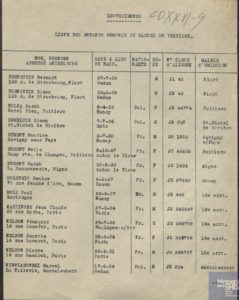
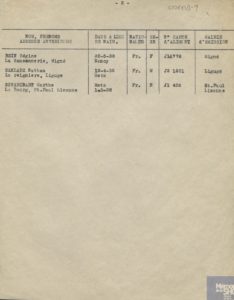
List of children from Louveciennes who had no clothing cards on November 10, 1943.
(Shoah Memorial)
Simon’s arrest and deportation (July 1944)
Early in the morning on July 22, 1944, all the children in Louveciennes were suddenly woken up, arrested and taken to Drancy camp. Cécile and Simon were booked in and placed together in room 3 on stairway 6. Since all the children from the various UGIF homes were arrested at around the same time, on the instructions of Aloïs Brunner, who was in charge of Drancy camp, they met up with their cousin Joseph Tabak, who was arrested at the Secrétan home, that same day, and with his brother Jacques, who was arrested at La Varenne, the following day.
Plaque commemorating the roundup of July 22, 1944 outside the “Séjour de Voisins” home in Louveciennes.
Simon’s second internment slip from Drancy camp.
(Shoah Memorial)
Page from the Drancy camp transfer book dated July 22, 1944. (Shoah Memorial)
Photo and plan of Drancy camp.
(Shoah Memorial)
The living conditions in Drancy were very tough, with poor hygiene, insufficient food, various diseases and uncertainty about the future. As the above records show, the camp was guarded by the French military police, who reported to the Police Headquarters at the time. The site was not chosen at random. It was a low-cost housing development which was still under construction in 1941, and its U-shape made it easy to convert into a detention center.
On July 31, 1944, the four cousins were deported to Auschwitz on Convoy 77. They made one final stop near Metz. The train stopped at Novéant, which was the first station in Moselle and thus the first station in Germany at that time. A new driver was assigned and the locomotive was refueled. The train arrived at Auschwitz on August 3. Cécile, her brother and cousins were all sent to the gas chambers. They were officially declared to have died on August 5, 1944.
Photo of the memorial stone near Novéant station, erected in 2016 in memory of the victims of all the deportation convoys that stopped there.


 Français
Français Polski
Polski